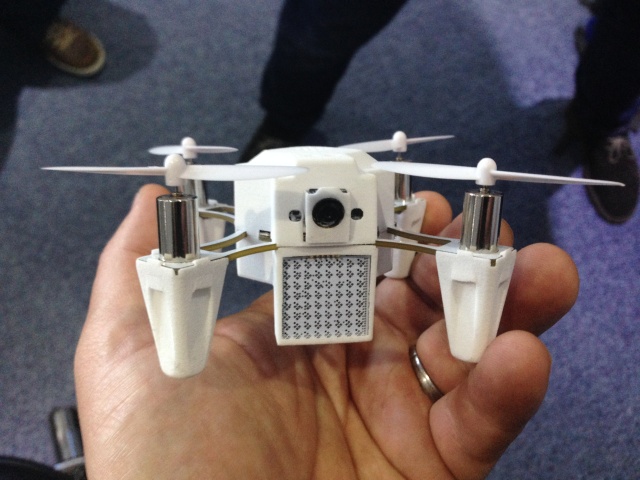
In a 13,000-word article first sent to backers of the Zano handheld drone and then re-posted on Medium, journalist Mark Harris concluded that Wales-based Torquing Group over-promised and under-delivered due to incompetence rather than malice.
"I don’t think any amount of time or money with those people would have resulted in a success," Harris told Ars. "I got the impression they were in over their head. They were out of their depth."
In December 2015, Kickstarter announced that it had hired Harris to figure out what happened. That move came just after Kickstarter proclaimed its bewilderment over how British drone startup Torquing Group raised £2.3 million ($3.4 million), only to totally fall apart in less than a year.
Essentially no one from the company would speak to Harris on the record except for former CEO Ivan Reedman.
"It’s tough to get inside a company when people don’t want to talk to you," Harris told Ars.
Reece Crowther, the company’s head of marketing, is rumored to have returned to his native Australia. (Crowther berated Ars over the phone in August 2015 after we reported on the company’s numerous delays—just months after we had visited its Pembrokeshire offices.)Harris reported that a crucial mistake that Torquing Group made was that in the early summer of 2015, its corporate board decided to "skip a genuine pilot build and head straight into full production."
"I was very strongly opposed to going down the avenue of committing so much to stock so early," the former CEO told Harris. "I made my opinion known, but ultimately, what happened happened. I understand the reasons why the operations team felt they needed to do that, because that would genuinely keep to the June shipping date."
But two employees who wished to remain anonymous seemed to indicate that the problem was largely hubris.
"The word ‘risk’ seemed to not exist at Torquing," the anonymous engineer said. "During the first months after the Kickstarter campaign, we were already the ‘winners’; the way ahead was a straight walk down from the top of a hill."
In the end, there doesn’t seem to be much hope for those who pledged money to support the project—in the eyes of British law, they are not considered creditors and thus will receive no money. Reedman himself "lost his company, his reputation, and his tools and is currently looking for work."
Lawyer up?
The lengthy piece ends with a brief but incomplete discussion about the inherent tension between Kickstarter’s desire to profit off of others' fundraising and its desire to distance itself when a project goes south.Kickstarter's terms of service only provide guidelines if such a project falls apart. "The creator is solely responsible for fulfilling the promises made in their project," the terms say. "If they’re unable to satisfy the terms of this agreement, they may be subject to legal action by backers."
In short, backers can attempt to take legal action, but Kickstarter won’t do so. Kickstarter CEO Yancey Strickler denied that the company doesn’t have skin in the game.
"I feel Kickstarter shares in the risks, absolutely," he told Harris. "It’s our reputation on the line every time. The only reason that Zano was able to raise this amount of money is because we have done such a good job administering this platform and working with trusted creators over the last six years. And when something like Zano happens, that burns. And [it] affects how someone looks at the next Kickstarter project."
Kickstarter's balancing of this tension is one that Harris ultimately finds unsatisfying, particularly as Kickstarter has grown rapidly and become a company that adheres to socially conscious principles. Since launching in April 2009, Kickstarter has helped artists, entrepreneurs, and others raise over $2 billion. Meanwhile, when individuals spend hundreds of dollars or more at a time and expect to get something for it, they can end up out of luck. (A study by the University of Pennsylvania and Kickstarter found that about 9 percent of projects fail to deliver.)"When crowdfunding was ‘give me 10 grand to make my album,’ that’s one thing," Harris told Ars. "Now, it looks more like a shop. These things appear to be finished products, or very close to finished products. We’re told that they do it at the end for marketing. Obviously that’s why Zano crashed so badly. You wouldn’t have so many people doing it if it wasn’t a convincing presentation. [Kickstarter wants] the excitement, but they want [to be] hands-off. I think [Kickstarter] could do more explicit warnings [of the site not being a store], particularly when individual people are spending large sums of money."
Kickstarter wouldn't say definitively whether they would hire another journalist in a similar case.
"The Zano project launched a month after we updated our terms of use," David Gallagher, a Kickstarter spokesman, told Ars. "One change in that update was that we laid out a path creators should follow if their projects are failing. The terms set up a contract between creators and backers that, if a project fails, requires the creator to come forward and explain what happened and how the money was used."
"In this case we heard from many backers who were not satisfied with the information they got about the project's failure," he added. "So we decided to help the backers get more information"
reader comments
99